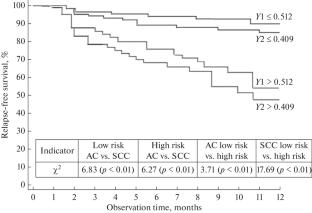Determination of the Risk of Tumor Progression in Patients with Early Stages of Adenocarcinoma and Squamous Cell Lung Carcinoma Based on Laboratory Parameters
Abstract—
Non-small cell lung cancer (NSCLC) dominates in the morbidity of lung cancer. In stage I, only 60–70% patients overcome the 5-year survival barrier, and in stage II 5-year survival rate is declining to 35–40%. The reason for such a high mortality is relapse of the disease. The main histological forms of NSCLC are adenocarcinoma (AС) and squamous cell carcinoma (SCC). They differ in course, protocols and effectiveness of treatment. Comparative survival data for AC and SCC are controversial, and reliable biomarkers for determining the risk of tumor progression still have not been found. In order to determine the risk of disease progression we have investigated the possibility of using laboratory parameters characterizing the level of some blood proteins involved in carcinogenesis in patients with early stages of AС and SCC. We retrospectively analyzed the duration of relapse-free period after surgical treatment for one year in 1250 patients (816 with stages I and II AC, G1-3 and 434 with early stages of SCC, G1-3). In 81 AC patients and 36 SCC patients (stages I−II, G1-3) we determined the level of CYFRA 21-1 and SCC, TPA, chemokines CXCL5, CXCL8, pyruvate kinase M2, HIF-1α, hyaluronic acid and receptors CXCR1, CXCR2, CD44v6. Using the Kaplan−Meier graphical analysis, groups of low (stage I G1-2 + stage II G1) and high (stage I G3 + stage II G2-3) risk of tumor progression were identified. The one-year survival rate of AС patients was higher than in SCC patients. AС patients with high risk of tumor recurrence had higher levels of CYFRA 21-1, the mean intensity of fluorescence (MFI) of CXCR1 receptor in granulocytes, and the relative content of CXCR2 receptor in lymphocytes than patients with low risk. In the case of rapid disease progression in SCC patients, the relative content of CXCR2 receptor in lymphocytes, the proportion of monocytes supplied with CD44v6 receptor, and SCC level were higher than in patients with slow progression. Regression equations, including combinations of the above parameters (threshold value for AC—0.512, for SCC—0.409, sensitivity—91.9% and 90.0%, specificity—90.0% and 87.5%, respectively), allow to predict the probability of tumor recurrence.


 求助内容:
求助内容: 应助结果提醒方式:
应助结果提醒方式:


